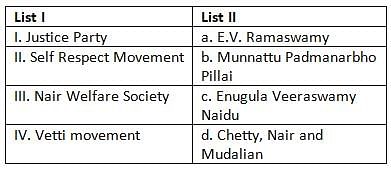APSET Paper 2 Mock Test - 5 (History) - AP TET MCQ
30 Questions MCQ Test - APSET Paper 2 Mock Test - 5 (History)
In the Mughal administration "Madad-I-Mash" indicates
Which of the following is true regarding Government of India Act 1935?
1. The Act never came in force; as princely states did accept the provision of the act.
2. The act abrogated the doctrine of Paramountcy of British over the Princely states in India.
Select the correct answer using the code given below: -
| 1 Crore+ students have signed up on EduRev. Have you? Download the App |
Consider the following statement about Hellenistic art :
1. The Sakas introduced features of Hellenistic art in the North-West frontiers of India.
2. The Hellenistic influence appears in the Pillars of Ashoka.
3. Gandhara art is the best example of Hellenistic influence.
Which of the statements given above is/are correct?
In which Buddhist Council, Buddhism was divided into Mahayana and Hinayana sects?
The ‘Dastaks’, the misuse of which was a source of constant friction between the nawab and the East Indian Company, were actually:
Consider the statements regarding to Dyarchy
1). In case of reserved subject Governor, though advised by ministers, could act in his own
2). Was abandoned all together in 1937
Which of the above statement(s) is/are correct?
In Pali texts, who among the following is referred to as Nigantha Nataputta?
Consider the following statements:
- A.O.Hume came to be known as the Founder Father of Congress.
- He was the one to suggest the name “Indian National Congress”.
- He was the author of “Old Man’s Dream”.
- The “Safety Value Theory” was the reason given by him in the formation of the “Indian National Congress”.
Choose the correct statements.
Tirthankara Parswanath’s idol is recognized by which symbol?
Which of the following statement is/are correct?
- The Marathas became the strongest power in southern India in the mid 18th century.
- Marathas played the role of king-makers at the Madras court.
- Marathas acted as the defenders of the country against foreign invaders like Ahmad Shah Abdali.
- Decline of the Mughal Empire was the rise of the Marathas under the Peshwa.
Select the correct code from below.
On which among the following dates, the Gandhi-Irwin Pact was signed?
Consider the following pairs:
1) Muzzafarpur Conspiracy Case:- Aurobindo Ghosh and Barinda Kumar Ghosh
2) Alipur Conspiracy Case:- Khudiram Bose and Prafulla Chaki
3) Kakori Conspiracy:- Ram Prasad Bismil, Ashfaqulla Khan
Choose the incorrect pair.
Who is the author of the book "The Story of the Integration of the Indian States"?
Consider the following statements regarding the Rig Vedic age:
1. During the Rig Vedic age, the king was elected by a tribal assembly called Samiti.
2. A standing army under the military commander was maintained by the king during the period.
Which of the statements given above are correct?
King Ashvapati of the Upanishadic Age was the ruler of which among the following Kingdoms?
Who was the priest of the Bharatas in the battle of Ten Kings ?
By which of the following for the first time, British government recognized the “Right of Dominion” for India?
Given below is the list of the rulers of the Maitraka dynasty. Arrange them in a proper sequence on the basis of founder to the last ruler.
1. Dhruvasena I
2. Dharasena I
3. Dronasimha
4. Bhatarka
Consider the following statements.
1. The term Saracenic has been derived from Roman people that lived in Arabia.
2. It was a synthesis of Victorian Gothic architecture with Mughal architecture.
3. The Pietra dura technique developed in French Gothic architecture.
Which of the above statements is/are correct?
With respect to the paintings in South India, consider the following statements.
I. Tanjore school of painting was developed by Chola rulers, dominated by the pictures of child Krishna.
II. The distinct school of Mysore painting evolved from the paintings of Vijayanagar times during the reign of the Vijayanagar Kings.
Choose the incorrect statements.
Below given are two statements, one is labelled as Assertion (A) and the other as Reason (R)
Assertion(A): Big buildings were the distinguishing feature of both Harappa and Mohen-jo-daro.
Reason(R): Their monuments symbolized the ability of the ruling class to mobilize labour and collect tax.
Select the correct answer using the codes given below :
During British Era, the Duke Memorandum became the basis of which among the following?


















